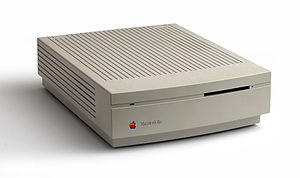Macintosh IIsi
 |
|
| Release date | October 15, 1990 |
|---|---|
| Introductory price | $ 2999 |
| Discontinued | March 15, 1993 |
| Operating system | System 6.0.7 to 7.6.1 |
| CPU | Motorola 68030 @ 20 MHz |
| Memory | 1 MB, expandable to 17 MB (100 ns 30-pin SIMMs) |
The Macintosh IIsi is an Apple Macintosh model in the Macintosh II series produced from 1990 to 1993. Announced at the same time as the Macintosh LC, the IIsi was the first Macintosh to ship with built-in sound-in capabilities. The LC also had a sound-in port but did not ship until later. Introduced as a low-cost alternative to the professional desktop models, it was also popular for home use, as it offered more expandability and performance than the LC series. It had color and could drive a number of different 12"-14" Apple monitors, with a maximum screen resolution of 640×480 in eight-bit color.
The IIsi's case design is a compact three-box desktop unit used for no other Macintosh model, one of the only Macintosh models of which this is true. Positioned below the Macintosh IIci as Apple's entry-level professional model, the IIsi's price was lowered by the redesign of the motherboard substituting a different memory controller and the deletion of all but one of the expansion card slots (a single Processor Direct Slot) and removal of the level 2 cache slot.
It shipped with either a 40-MB or 80-MB internal hard disk, and a 1.44-MB floppy disk drive. The MC 68882 FPU was an optional extra, mounted on a special plug-in card. Ports included SCSI, two serial ports, an ADB port, a floppy drive port, and 3.5mm stereo headphone sound output and microphone sound input sockets.
A bridge card was available for the IIsi to convert the Processor Direct slot to a standard internal NuBus card slot, compatible with the other II-series Macintoshes. The bridge card included a math co-processor to improve floating-point performance. The NuBus card was mounted horizontally above the motherboard.
To cut costs, the IIsi's video shared the main system memory, which also had the effect of slowing down video considerably, especially as the IIsi had 1 MB of slow RAM soldered to the motherboard. David Pogue's book Macworld Macintosh Secrets observed that one could speed up video considerably if one set the disk cache size large enough to force the computer to draw video RAM from faster RAM installed in the SIMM banks.
...
Wikipedia
